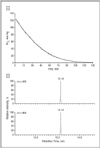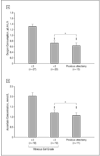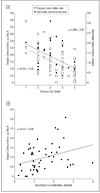The gel state of the vitreous and ascorbate-dependent oxygen consumption: relationship to the etiology of nuclear cataracts
- PMID: 19365028
- PMCID: PMC2683478
- DOI: 10.1001/archophthalmol.2008.621
The gel state of the vitreous and ascorbate-dependent oxygen consumption: relationship to the etiology of nuclear cataracts
Abstract
Objective: To investigate the rate and mechanism of oxygen consumption by the vitreous.
Methods: Oxygen consumption was measured with a microrespirometer. Vitreous ascorbate was measured spectrophotometrically and by gas chromatography-mass spectrometry. Vitreous degeneration was related to the rate of oxygen consumption and ascorbate concentration in samples obtained during vitrectomy.
Results: Prolonged exposure to oxygen or treatment with ascorbate oxidase eliminated oxygen consumption by the vitreous. Adding ascorbate restored oxygen consumption. Oxygen consumption persisted after boiling or treating the vitreous with the chelating agents EDTA and deferoxamine. In patients undergoing retinal surgery, liquefaction of the vitreous and previous vitrectomy were associated with decreased ascorbate concentration and lower oxygen consumption.
Conclusions: Ascorbate in the vitreous decreases exposure of the lens to oxygen. The catalyst for this reaction is not known, although free iron may contribute. The gel state of the vitreous preserves ascorbate levels, thereby sustaining oxygen consumption. Vitrectomy or advanced vitreous degeneration may increase exposure of the lens to oxygen, promoting the progression of nuclear cataracts.
Clinical relevance: Determining how the eye is protected from nuclear cataracts should suggest treatments to reduce their incidence.
Figures




References
-
- Murray CJL, Lopez AD. Global Burden of Disease: A Comprehensive Assessment of Mortality and Disability From Diseases, Injuries, and Risk Factors in 1990 and Projected to 2020. Cambridge, MA: Harvard School of Public Health; 1996.
-
- Salm M, Belsky D, Sloan FA. Trends in cost of major eye diseases to Medicare, 1991 to 2000. Am J Ophthalmol. 2006;142(6):976–982. - PubMed
-
- Spector A. Oxidative stress-induced cataract: mechanism of action. FASEB J. 1995;9(12):1173–1182. - PubMed
-
- Truscott RJ, Augusteyn RC. Oxidative changes in human lens proteins during senile nuclear cataract formation. Biochim Biophys Acta. 1977;492(1):43–52. - PubMed
-
- Holekamp NM, Shui Y-B, Beebe D. Lower intraocular oxygen tension in diabetic patients: possible contribution to decreased incidence of nuclear sclerotic cataract. Am J Ophthalmol. 2006;141(6):1027–1032. - PubMed
Publication types
MeSH terms
Substances
Grants and funding
LinkOut - more resources
Full Text Sources
Other Literature Sources
Medical

